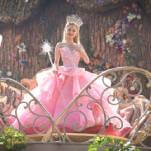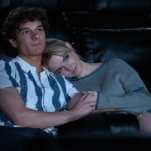“And the third angel sounded. And there fell a great star from heaven, burning as it were a lamp. And it fell upon the third part of the rivers, and upon the fountain of waters. And the name of the star is called Wormwood. And the third part of the waters became Wormwood. And many men died of the waters, because they were made bitter.” —Revelation 8:10, King James Bible
“[aside] Wormwood, wormwood!” —Hamlet, Act III Scene 2
The Hotel Statler in Midtown Manhattan. Room 1018A. November 28, 1953. Sometime between 2:30 and 2:35 a.m. A man speaks on the phone while another man watches television. “I’ll see you tomorrow. I love you, Alice,” says the man on the phone. He lies on his bed only to impulsively shut off the television, frustrating the second man. He reads the Bible in bed. Images flood his memory—fire, water, war, family. He hears a sudden turn of the doorknob. He goes to inspect the door, looks through the peephole, and sees a shadowy man wading in the water. He leaves the room and walks down the hallway. Or is he walking in place? He then reenters his room.
Suddenly the man goes through the window and plummets to his death. His name is Frank Olson and he was possibly murdered by the CIA.
Director Errol Morris’s new miniseries Wormwood follows two parallel stories: 1. The present-day retelling of Frank Olson’s death and the subsequent multi-decade fallout from the primary perspective of his son Eric, who has been obsessed with the case since he was a child, and 2. a dramatization of what did and possibly could have happened in the days leading up to Frank’s death, partially based on declassified documents provided to the Olson family. Morris blends documentary and narrative techniques to tell Frank’s story, but Wormwood never settles just for Frank. It becomes an exploration on the dissemination of “truth,” and how certain forces can manipulate reality on a large scale to privilege certain narratives over others. Sure, it’s a metaphor for storytelling, as most hybrid documentaries are, but it’s more potently a meditation on how obfuscation engenders bitterness and how the truth will never quell doubt nor fulfill expectations.
That’s a lot of information to take in, and “Suicide Revealed,” the first chapter of Wormwood, similarly engulfs the audience in information, imagery, and considerable intellect. Eric Olson tells Morris about the day he learned of his father’s accident and how the confounding phrase “he fell or jumped out the window” sparked his obsession with the truth. We jump ahead to 1975 when the Rockefeller Commission Report was published; the report confirms that the CIA ran a drug program testing the effects of LSD on unsuspecting individuals. The report also all but confirms that Frank was dosed with LSD as a part of the program nine days before his death, and that the subsequent psychological trauma possibly provoked his suicide. The Olson family plans to sue the CIA but they’re temporarily placated when President Ford invites them to the Oval Office for an in-person apology.
But that’s neither the whole truth nor the whole story. In upcoming episodes, Morris and Olson dig deeper into how the government continued to misdirect and outright lie about the real nature of Frank’s death. However, in this first part, it’s important that Morris lays out the information discovered by journalists and disseminated from the government so that it can be questioned and taken apart later in the series. Moreover, Morris also hints at certain ideas and digressions that occupy Wormwood—Eric’s identification with Hamlet, the government’s use of germ warfare in the Korean War, and mental fragmentation on a personal and national level. There are bits and pieces of throwaway information in this first chapter that will percolate over the course of the series, but Morris doesn’t telegraph anything. Instead, it’s an aural and visual tapestry that’s designed to initially disorient and bewilder.
Wormwood makes many compelling formal choices, many of which will be clarified in further installments. Morris forgoes his Interrotron-informed visual style for his interviews and instead employs a multi-camera set-up, which allows him to “chop up” shots of Eric from multiple angles into different patterns. The cinematography is frenetic and occasionally chaotic, but it’s fitting of both the style and tone of the series. Morris intersperses photographs, old footage, and close-ups of newspaper clippings and other documents between the interviews that simulates the unconscious mind’s capacity for free association.
Then there are the dramatizations of Frank’s last days (Morris apparently hates the word “reenactment,” a description that also doesn’t really apply to Wormwood), which serve to purposefully muddy all the waters. DPs Ellen Kuras and Igor Martinovic shoot these scenes with a Rockwellian bent, capturing the superficially placid 1950s life. But they also fill the frame with visual digressions and outright hallucinatory imagery. In the cabin when Frank and fellow members of the Special Operations division at Fort Detrick are slipped LSD, Morris lingers on a shot of a moose head that briefly appears to snort. In that same vein, we learn that the shadowy man wading in the water was Frank in the woods of Maine. Or did he? Was Frank even at the cabin? “You kind of lose a baseline of assumptions because now you’re questioning everything,” Eric says near the end of the episode. Wormwood strives to place you in that mindset.
Stray observations
- Welcome to Wormwood coverage at The A.V. Club. My name is Vikram Murthi and I will be your host for the next week. Recaps will drop every day until Saturday. I have seen the full series and I will try to keep “spoilers” (if you can call them that) to a minimum. And if you’re looking for further Wormwood coverage, read Mike D’Angelo’s review of the theatrical cut here.
- If the collage style of Eric’s interviews feels random and haphazard, trust me when I say that it will make sense going forward.
- “We’re the only people in the whole history of this country who ever got an apology from the president in the Oval Office for the unintended consequences of some government policy. I mean, you really gotta stop for a minute and pause and go, ‘Wow. How often does that happen?’ That would be zero. It doesn’t happen.”







































